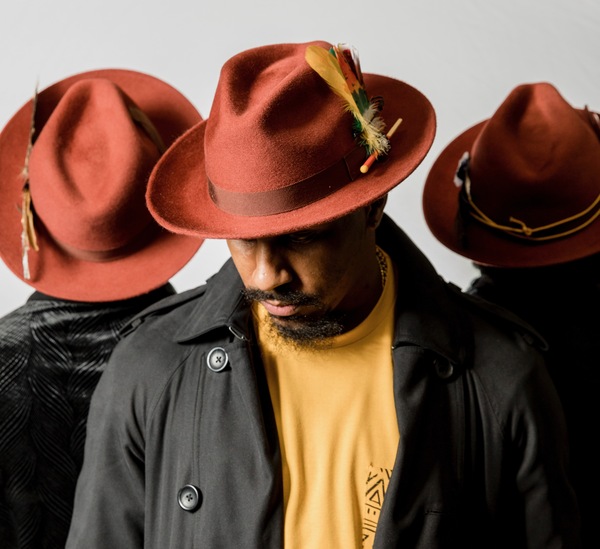In a world where fashion often follows trends, Jordan Sullen has boldly stepped into his own lane—crowning culture with purpose through Hatrimony Hat Company. Born out of a deeply personal journey and a divine nudge, Hatrimony has quickly become Georgia’s premier hat destination, redefining what it means to wear your story with pride. From honoring the legacies of Black men who came before him to crafting custom pieces that speak volumes without a word, Sullen’s approach to design is more than just stylish—it’s soulful. As he weaves tradition, family, and faith into every brim, he’s not just building a brand—he’s curating a movement.
TNJ: What inspired you to create Hatrimony Hat Company?
Sullen: The conception of Hatrimony came during a deeply reflective season in my life. I was emerging from an environment where I felt completely undervalued—loyal to something that no longer served me. Truthfully, I had no plans to start over. I was done.
But after countless conversations with my wife and mother-in-law—two of the most patient, encouraging women I know—something shifted. One day, while driving and processing everything, God spoke to me in a way I couldn’t ignore. I realized the weight of what I was carrying—how it was affecting my marriage, my family, and my peace of mind. Through prayer and surrender, I received divine clarity: it was time to move forward into something greater. That moment didn’t just birth a business—it birthed purpose. God gave me the name: Hatrimony. What started as a whisper became Georgia’s #1 hat shop.
TNJ: What does the name “Hatrimony” mean to you?
Sullen: To me, “Hatrimony” is about commitment. It’s a fusion of heritage, unity, and storytelling—like a marriage, but with style. Every hat we create is built with intention and love. It’s not just fashion—it’s family.
TNJ: What role have hats played historically in Black culture and fashion?
Sullen: Hats have always been woven into the fabric of Black culture—they’ve told our stories when words couldn’t. In New Orleans where I grew up, hats weren’t just decorative. They were symbolic. Whether in church pews, second lines, Masonic halls, or Mardi Gras parades—hats represented identity, pride, and place. Historically, hats were tools of resistance and dignity. During the Civil Rights Movement, they gave our people a unified look—strength in presentation. They were symbols of empowerment. My father and grandfathers were major influences. Even when money was tight, they had great hats. Sharp ones. It gave them a sense of pride and presence. Now, being able to crown my father with one of my own creations? That’s legacy in motion.
TNJ: Talk a bit more about the significance of hats in our community
Sullen: Hats have always held sacred space in Black life—especially in church, community, and resistance movements. They symbolize reverence, resilience, and representation. The Black Panther Party’s berets instantly come to mind—bold, militant, intentional. Same with the dignified fedoras of Civil Rights leaders like Dr. King. Hats helped unify movements and made statements without words. Growing up Baptist, I saw how deeply women revered their hats. They were signals of stature, style, and structure. The elders knew what time it was—every hat had its own voice. That lesson still resonates. No matter how well you dress, a hat always takes it up a notch. It demands attention—and respect. Even in the house of the Lord. Amen?
TNJ: Do you recall your first real connection to hats—maybe one you saw or wore that left an impression?
Sullen: Absolutely. While my dad introduced me to hats, it was my mom who shaped my eye for style. She could put together a look like no one else—and her hats always added an element of mystery. She wore them effortlessly. My first real hat was a wool houndstooth fedora from Dillard’s. I bought it for my winter formal but chickened out at the last minute—didn’t want the jokes. But eventually, I found the confidence to rock it. That choice planted a seed. It sparked a journey of personal style, one that’s still evolving. From that day forward, I never looked back. Hats became my armor—and now, I help others discover that same feeling.
TNJ: What makes a hat more than just an accessory? When does it become a statement?
Sullen: Most hats are just that—hats. But a Hatrimony hat? That’s a statement. My goal was never just customization—it was storytelling. I want people to feel seen, understood, and celebrated through their hat. Each piece we create is rooted in identity. We ask the wearer: “What defines you?” The answer informs the design. Some hats carry one strong narrative, others are a blend—but either way, the hat speaks before you do. A hat becomes a statement when it reflects the truth of who you are. And the dopest part? Even if someone isn’t vibing with me personally, they still respect the hat. The language of confidence is universal.
TNJ: How do you balance tradition and innovation in your designs?
Sullen: For me, it’s about integrity. Every hat we produce—whether by my hand or a team member’s—is something I’d proudly wear. That’s the standard. It has to be something my grandfather, my father, or my brother would appreciate. Our designs are lived-in—born from real memories, emotions, and cultural moments. I respect tradition, but I also challenge the norm. That mix has caught the attention of tastemakers and cultural icons alike. I’m not in it for clout, but when people take notice, it’s confirmation that our work is moving the needle. I’m here to change what people think millinery should look like—and who they think it’s for.
What do you want someone to feel when he or she puts on one of your hats?
Sullen: Confidence. Period. I want people to feel like the best version of themselves.
I’ve had men walk into the shop unsure of themselves—some sent by their wives—and leave with a whole new aura. I’ve received texts and DMs from people saying my hats helped them rediscover self-worth or embrace their identity in a new way. That tells me I’m doing more than selling hats—I’m doing God’s work. Helping people feel seen. And that will always be enough for me.
TNJ: How has your personal journey shaped the vision and values behind your brand?
Sullen: Hatrimony wouldn’t exist without my journey through matrimony. My wife and mother-in-law saw the vision long before I did. But I resisted, mostly out of loyalty—to people, places, and things that no longer served me. Eventually, God’s voice became louder than even theirs. He showed me the path forward. That obedience birthed a space rooted in elevation, unity, and truth. This brand was never just about style—it was about upliftment. It’s about crowning our people, creating sacred spaces, and building legacies through the craft. And in doing that, Hatrimony pulled me up from a low place. That’s what makes it special. That’s what keeps it real.
TNJ: Is there one customer’s story that reminded you why you do this work?
Sullen: There are so many, but one recent story touched me deeply. A woman reached out to surprise her father with a custom hat. She was driving all the way from Miami to Atlanta—just for this moment. He had fallen in love with our brand through social media, and she wanted to bring his vision to life. When they arrived, it wasn’t just her and her dad—six family members pulled up in full support. We talked, laughed, shared stories, and I began crafting his custom “Godfather” style piece. When I finished, the look on their faces said it all. Her father called me a “master,” and we all embraced like old friends. That moment reminded me why I pour so much into this work—it’s never just about hats. It’s about heart.
TNJ: How do you see hats evolving in fashion, and what role do you want Hatrimony to play in that future?
Sullen: The evolution is already happening—and I’m grateful to be at the forefront. Hats are becoming more gender-neutral, more personal, and more expressive than ever before.
At Hatrimony, we offer a blank canvas for self-expression. No two wearers will ever tell the same story with the same hat. That’s the magic. My role in the future? To continue building a culture around hats. To make hat-wearing a lifestyle, not a trend. And to remind people—especially our people—that style is about more than what you wear. It’s about what you carry with you.








